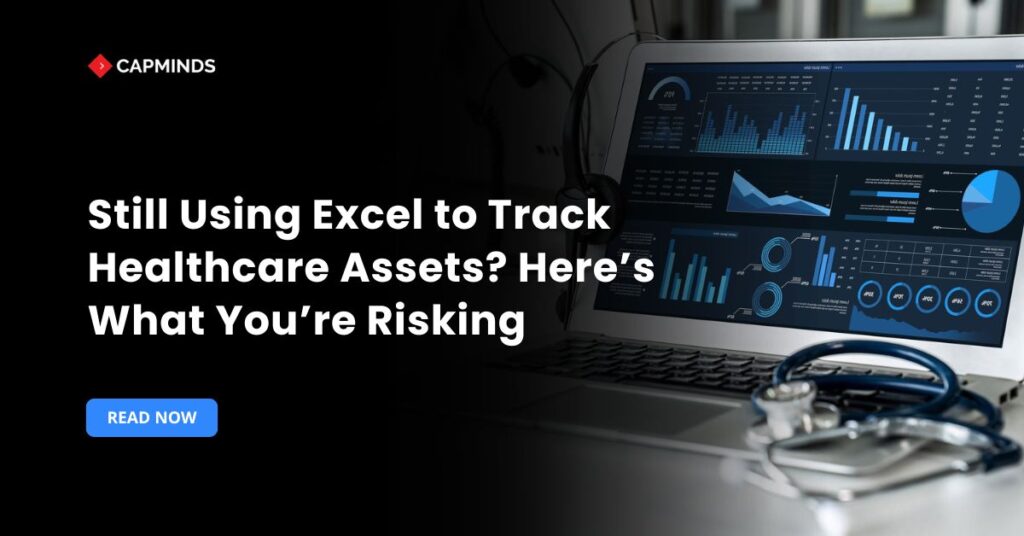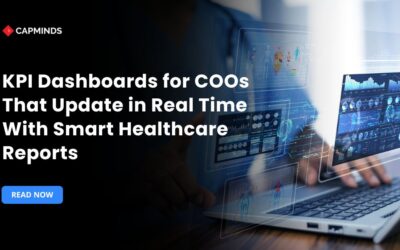Still Using Excel to Track Healthcare Assets? Here’s What You’re Risking
Excel spreadsheets are a familiar tool for many administrators, but when it comes to managing medical equipment and other healthcare assets, relying on Excel carries hidden dangers. Tracking ventilators, monitors, wheelchairs, and supplies in static files can lead to stale data, errors, and inefficiencies that directly affect patient care.
Nurses in U.S. hospitals now spend over an hour each day just searching for equipment when assets aren’t tracked digitally. Hospitals that lean on Excel often face lost or misplaced devices, missed maintenance, and compliance gaps.
Below, we explore why spreadsheets fall short in healthcare settings and how modern health data analytics dashboards solve these problems.
The Hidden Pitfalls of Excel-Based Tracking
Healthcare asset tracking demands accuracy, timeliness, and strict accountability. Spreadsheets simply aren’t designed for this level of complexity, leading to several critical issues:
1. Outdated and gap data
Excel files must be manually updated and shared, creating lag and fragmentation. As one analysis notes, hospitals that kept inventories in Excel “often fail to update” the list when equipment was damaged, lost, or retired, resulting in no clear picture of available assets. If you rely on emailed spreadsheets, you’ll almost certainly be working with stale data.
2. Error-prone manual entry
Spreadsheets depend on human input, so typos and mistakes are inevitable. Studies show nearly 90% of Excel spreadsheets contain errors. In a hospital, even a single wrong entry could wrongly mark a critical device as available or in compliance.
Organizations grow, and these “trusty spreadsheets quickly become a bottleneck, leaving you with incomplete or inaccurate data”. The more rows and users involved, the higher the risk of mistakes slipping through.
3. Poor collaboration and version control
Multiple staff across departments often need to access asset lists. With Excel, they end up sending files back and forth or overwriting each other’s changes.
There’s no reliable audit trail of who changed what, and which file is current. This “glorified ledger” approach makes teams inefficient; your staff wastes hours reconciling copies instead of focusing on care.
4. Lack of automation
Spreadsheets don’t alert you when maintenance is due or warranties expire. All reminders must be set up manually. In manual systems, a technician must remember to check the logs for a defibrillator due for inspection, whereas an automated platform would simply queue the task and send a notification. Without automation, key actions slip through the cracks, leading to failed inspections or emergency breakdowns.
5. Compliance and audit risk
Healthcare assets are governed by strict regulations. Tracking inspection dates, certifications, and audit logs in Excel is cumbersome and unreliable. Prometheus Group warns that spreadsheets offer no inherent accountability – you can’t easily see who changed what, and there’s often no secure audit trail.
This makes passing inspections and proving compliance a major headache. Spreadsheets “record data but don’t drive action,” resulting in “missed maintenance, lost equipment, and preventable downtime”. In a crisis, not knowing where a calibrated device is could have life-or-death consequences.
6. Scalability and performance limits
Excel has row limits and slows down with large data sets. A hospital with hundreds of beds and thousands of assets will quickly outgrow spreadsheets.
Splitting data into multiple files creates even more complexity. Inventory expands, and the process of finding up-to-date information “takes more time than you can afford”. Spreadsheets simply do not scale to the size and speed modern healthcare demands.
7. Wasted time and money
Every minute staff spend hunting for equipment is a minute taken from patient care. Nurses spend over an hour daily searching for devices when no real-time tracking is in place.
This inefficiency has a cost. Industry studies estimate U.S. hospitals lose around $4,000 worth of equipment per bed each year due to theft or misplacement. Every misplaced infusion pump or ECG machine is a wasted capital expense.
Collectively, these issues mean patient care can suffer, delayed treatments, cancelled surgeries, or equipment breakdowns at critical moments. Relying on spreadsheets leads to “costly inefficiencies across care, compliance, and capital planning”. In short, Excel might feel free and familiar, but the hidden costs are steep.
The Cost of Inaction: Patient Safety and Compliance
When equipment isn’t tracked properly, it’s not just spreadsheets that suffer; it’s patients. For example, losing a set of ventilators or defibrillators can force staff to choose between patients or delay life-saving care.
Any equipment delay can be life-threatening, noting that missing gear causes “delayed treatment that can even lead to death”. Even routine care is affected: if a needed wheelchair or monitor is unavailable, patients wait longer, and bed turnover slows.
Beyond patient impact, healthcare organizations face financial and regulatory consequences from poor asset tracking. Missing medical devices cost real money.
- Reports show that 10–20% of a hospital’s inventory goes missing each year, amounting to roughly $4,000–$5,000 worth of assets lost per bed annually.
- This hidden loss strains already tight budgets.
- Worse, failing a compliance audit can trigger fines.
- Modern regulations now expect “100% traceability” of critical equipment.
- With Excel, proving that a yearly MRI calibration was done on time is manual and error-prone.
- Any discrepancy opens the door to penalties and reputational harm.
The Benefits of a Healthcare Asset Analytics Dashboard
Instead of juggling spreadsheets, a modern health data analytics dashboard connects asset information in real time and presents it through intuitive visualizations. Consider how these platforms transform asset management in healthcare:
1. Real-time inventory visibility
Assets are tagged and tracked continuously. The dashboard instantly shows where each device is and what status it’s in. For instance, you can see if an infusion pump is in use, being cleaned, or idle on a ward. With this live view, nurses no longer roam hallways; they simply check the dashboard, find the nearest available equipment, and dispatch staff immediately.
Data capture and analytics let you monitor utilization, downtime, and even the last service date of every asset. In practice, organizations report massively reduced search times.
One healthcare provider moved off Excel to an asset platform and cut several hours per week of manual inventory work into minutes.
2. Automated maintenance and alerts
The dashboard can automatically schedule preventive maintenance and generate tickets when needed. Rather than scouring logs for expiring inspections, a system will send out alerts before deadlines.
A connected asset management system “automates preventive maintenance, syncs with compliance schedules,” and keeps a live compliance status for every device. In effect, the software becomes a digital watchdog, never letting a crucial test or calibration slip.
3. Actionable analytics and insights
Beyond tracking location, an analytics dashboard crunches the data into useful insights. You can instantly see which equipment is underutilized, which has high downtime, or which units are aging out of warranty.
- Integrated analytics let you measure each asset’s performance, utilization rates, return on investment, and maintenance history.
- Armed with this intelligence, administrators make informed decisions: for example, deferring the purchase of a new device if utilization is low, or reallocating busy machines to understaffed departments.
- In one case, a hospital was able to optimize capital planning and extend equipment lifecycles by up to 25% using data-driven asset insights.
4. Improved collaboration and accessibility
Web-based dashboards ensure every team member works from the same data. Authorized staff can log in from any device to check assets or update records.
This eliminates the “multiple versions” problem of Excel. Now, if a technician repairs a pump, that update is immediately visible to all users. The single source of truth prevents conflicts and speeds up the workflow. In short, the organization stops chasing files and starts sharing insights.
5. Cost savings and ROI
Reducing losses and avoiding unnecessary purchases translates directly to the bottom line. By preventing just a few high-value devices from going missing, a hospital can save tens of thousands of dollars.
- Add to that the saved labor hours, and the investment in a dashboard solution typically pays for itself quickly.
- Asset tracking vendors even document real cases: one company saved 3–4 hours per week of work by replacing Excel with a unified asset system.
- Those reclaimed hours are now used on patient care instead.
6. Enhanced patient outcomes
With all assets accounted for, patient care improves. When critical gear is always at hand and functioning, treatments proceed without delay.
In an emergency, staff trust the dashboard to guide them to a working defibrillator or ventilator nearby. The stress of last-minute equipment hunts is removed, and care teams can focus entirely on patients.
7. Regulatory confidence
Finally, digital dashboards make audits easy. All maintenance actions and asset movements are logged automatically with timestamps and user IDs.
Health regulators increasingly expect “full digital documentation and up-to-date inventory for all critical assets”. A good dashboard provides instant proof of compliance, from calibration certificates to inspection dates, eliminating the guesswork that comes with Excel.
Related: Custom Dashboards vs. Off-the-Shelf BI in Healthcare: What Does Your Organization Need?
Key Features to Look For in a Healthcare Asset Dashboard
When evaluating digital asset tracking platforms or dashboards, hospitals should look for these capabilities:
- Real-Time Location Tracking: Use RFID, BLE, or GPS to pinpoint each asset’s current location across buildings or floors. No more calling around or walking the halls to find a unit.
- Mobile Access: A companion app or mobile-friendly interface lets technicians scan barcodes/QR codes and view asset info on the go. They can update the status or log maintenance in seconds.
- Automated Scheduling & Alerts: The platform should flag assets for service based on usage and calendar schedules, then auto-assign work orders. This frees staff from manually tracking deadlines.
- Customizable Dashboards and Reporting: Look for rich analytics, charts, and tables that show utilization trends, upcoming maintenance, and equipment age. Visualization tools should let you drill down into the data to understand issues at a glance.
- Integration with Other Systems: The ideal dashboard can pull in data from your ERP/CMMS or EHR. For example, it might sync financial records for depreciation or link device alerts to patient admission systems. Facilio notes that integration is important “to optimize operations”.
- Security and Compliance Features: Ensure the system has user access controls, audit logs, and data encryption. It should support electronic signatures or checklists for quality checks and comply with healthcare IT regulations.
- Scalability: Choose a solution that can handle your entire asset base, from wheelchairs and IV stands to MRI machines and hospital IT equipment, and expand as your organization grows.
By selecting a dashboard with these features, healthcare leaders turn asset management from a burden into a strategic asset.
Transform Asset Tracking with CapMinds Healthcare Analytics Dashboards Solution
Manual spreadsheets have no place in modern healthcare.
CapMinds empowers hospitals and healthcare organizations with intelligent analytics dashboards that eliminate inefficiencies, reduce asset loss, and improve clinical readiness.
With our custom healthcare analytics and BI dashboard development services, we help you gain real-time insights and automate the entire asset lifecycle.
Our Services Include:
- Custom Healthcare Asset Analytics Dashboards
- BI Dashboards with Real-Time Data Visualization
- Automated Maintenance Scheduling & Alerts
- EHR & ERP System Integration
- Mobile-Ready Asset Management Interfaces
- Role-Based Access Controls & Audit Trails
Modernize your hospital’s operations, optimize asset ROI, and meet compliance standards effortlessly. With CapMinds, you’re not just tracking assets, you’re unlocking data-driven healthcare operations.
Book a free consultation call with our experts and see how we can digitize your healthcare asset tracking.




